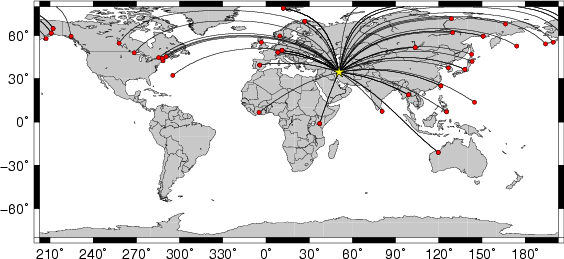
Location of the earthquake (yellow star) and great circle path from the epicenter to each station (red) [created using GMT (Wessel, P., and W. H. F. Smith, New version of Generic Mapping Tools released, EOS Trans. AGU, 76 329, 1995.)]
2007/06/18 14:29:54 34.48 50.84 42
The following compares this source inversion to the USGS Rapid Moment Tensor Solution and to the Harvard CMT solutions, if they are available.
SLU Moment Tensor Solution
2007/06/18 14:29:54
Best Fitting Double Couple
Mo = 1.24e+24 dyne-cm
Mw = 5.33
Z = 15 km
Plane Strike Dip Rake
NP1 143 63 121
NP2 270 40 45
Principal Axes:
Axis Value Plunge Azimuth
T 1.24e+24 60 98
N 0.00e+00 27 307
P -1.24e+24 13 211
Moment Tensor: (dyne-cm)
Component Value
Mxx -8.67e+23
Mxy -5.66e+23
Mxz 1.53e+23
Myy 4.13e+16
Myz 6.74e+23
Mzz 8.67e+23
--------------
----------------------
#---------------------------
##----------------------------
####---------########-------------
######--####################--------
#####--##########################-----
####-----###########################----
##-------#############################--
##---------#############################--
#-----------############### ###########-
-------------############## T ############
---------------############ ############
---------------#########################
----------------########################
-----------------#####################
------------------##################
-------------------###############
---- -------------##########
--- P -----------------#####
-------------------
--------------
Harvard Convention
Moment Tensor:
R T F
8.67e+23 1.53e+23 -6.74e+23
1.53e+23 -8.67e+23 5.66e+23
-6.74e+23 5.66e+23 4.13e+16
|
07/06/18 14:29:54.09
CENTRAL IRAN
Epicenter: 34.478 50.839
MW 5.5
USGS MOMENT TENSOR SOLUTION
Depth 11 No. of sta: 30
Moment Tensor; Scale 10**17 Nm
Mrr= 1.58 Mtt=-0.71
Mpp=-0.87 Mrt= 0.15
Mrp=-0.97 Mtp= 0.94
Principal axes:
T Val= 1.93 Plg=69 Azm=101
N 0.00 15 325
P -1.93 14 231
Best Double Couple:Mo=1.9*10**17
NP1:Strike=301 Dip=34 Slip= 62
NP2: 154 60 108
-------
#----------------
###------------------
###-#########------------
#-----##############---------
--------###############--------
--------#################------
---------###################-----
----------######### #######----
----------######### T ########---
-----------######## ########---
------------###################--
------------##################-
--- -------#################-
-- P ---------###############
-----------###########
--------------#######
---------------##
-------
|
June 18, 2007, CENTRAL IRAN, MW=5.5
Goran Ekstrom
Meredith Nettles
CENTROID-MOMENT-TENSOR SOLUTION
GCMT EVENT: C200706181429A
DATA: II IU IC GE CU
L.P.BODY WAVES: 61S, 107C, T= 40
MANTLE WAVES: 16S, 17C, T=125
SURFACE WAVES: 82S, 159C, T= 50
TIMESTAMP: Q-20070618221327
CENTROID LOCATION:
ORIGIN TIME: 14:29:54.0 0.2
LAT:34.47N 0.01;LON: 50.74E 0.01
DEP: 19.8 0.5;TRIANG HDUR: 1.4
MOMENT TENSOR: SCALE 10**24 D-CM
RR= 1.570 0.044; TT=-1.660 0.034
PP= 0.088 0.030; RT= 0.577 0.073
RP=-1.020 0.078; TP= 1.350 0.025
PRINCIPAL AXES:
1.(T) VAL= 2.093;PLG=62;AZM= 94
2.(N) 0.541; 24; 307
3.(P) -2.636; 14; 211
BEST DBLE.COUPLE:M0= 2.36*10**24
NP1: STRIKE=272;DIP=38;SLIP= 48
NP2: STRIKE=141;DIP=63;SLIP= 117
-----------
-------------------
#----------------------
###-------######-----------
####-##################------
####--#####################----
##----#######################--
#-------#######################--
---------############ ########-
----------########### T #########
------------######### #########
------------###################
--------------#################
---------------##############
----- ---------##########
--- P ------------#####
- ---------------
-----------
|
USGS research CMT: maintained and developed by Jascha Polet at UC Santa Barbara.
This is a research system and solutions are *not* official USGS earthquake magnitudes.
AUTOMATIC solution, not reviewed by a seismologist
--------------------------------------------------
General region : 2007dtaw CENTRAL IRAN
surface waves (3.0,3.5,7,7.5 mHz)
Stations used : AAK ARU ESK KEV KMBO KONO KURK LVZ TLY
Origin time: 2007 169 14 29 54
Original location (lat,lon,depth) : 34.5000 50.8000 42
Moment tensor (x1.e26 dyncm) :
Mrr : 0.039203 Mtt : -0.025001
Mff : -0.014202 Mrt : 0.003247
Mrf : -0.012339 Mtf : 0.019050
T-axis: moment= 0.042 plunge= 77.285 azimuth= 93.952
N-axis: moment= -0.001 plunge= 10.359 azimuth= 309.842
P-axis: moment= -0.041 plunge= 7.292 azimuth= 218.502
best double couple: Mo= 0.041(x1.e26 dyncm) Mw=5.7 tau= 1.9
nodal planes (strike/dip/slip): 137.72/ 53.13/102.99 296.69/ 38.78/ 73.32
Centroid location : 34.778 50.381 47.032
Centroid time : -0.874
Variance reduction (%) : 16
***********
**** ****
*** ***
**o--oooooooooo- **
**ooooo--------oooooo- **
*ooo-----------------oooo- *
* -o--------------------ooo- *
** -o---------------------ooo- **
* oo----------------------oo-- *
** o------------------------oo--**
** oo---------+--T-----------o--**
** ooo----------------------oo-**
* oo----------------------o-*
** ooo--------------------o**
* ooo-------------------*
* ooo----------------*
** ooooo----------**
** P -oooooooooo**
*** ----***
**** ****
***********
0- 30- 60- 90- 120- 150- 180- 210- 240- 270- 300- 330-
z-comp: 0 0 0 0 2 1 0 2 0 0 0 1
r-comp: 0 0 0 0 1 0 1 1 0 0 0 0
t-comp: 0 0 0 0 2 0 2 1 0 0 0 0
Total number of traces used = 14
number of runs = 3
starttime = Mon Jun 18 08:54:20 MDT 2007
endtime = Mon Jun 18 08:59:18 MDT 2007
inversion time = Mon Jun 18 08:59:16 MDT 2007 - Mon Jun 18 08:59:18 MDT 2007
Solution produced by inversion of channels with var red > 2%
_______________________________________________
|
The following broadband stations passed the QC and were used for the source inversion. AKUT BBSR BFO BILL CHTO COLA DAV DBIC ERM ESK EYMN FFC GRFO GUMO HRV INCN KBS KDAK KEV KMBO KONO LBNH LONY MA2 MAJO MBWA PAB PALK PKME PMR SDPT SKAG SMY TATO TIXI TLY YAK YSS
All observed and Greens function waveforms are corrected to instrument response to ground velocity in meters/sec for the passband of 0.004 - 5 Hz. The traces were then lowpass filtered at 0.25 Hz and interpolated to a sample rate of 1 second.
For the deviatoric moment tensor inversion, the observed traces and Green's functions are read in an cut using the following commands
#####
# Driver script for the teleseismic waveform inversion
#
# The depth HS must be of the form 0010 for a depth of 1.0 km
# of 6700 for a depth of 670.0 km
#
# The Filter_Band is an integer with the following meansing
#
# FILTER_BAND 1/FH 1/FL
# 1 60 12 for Mw < 6.4
# 2 100 20 6.4 =< Mw < 6.8
# 3 120 40 6.8 =< Mw < 7.2
# 4 143 80 7.2 =< Mw < 9.3
#####
# Source duration - halfwidth of triangular function
# this filters only the Green functions
#
# halfwidth = 1.05 * 10-8 * M0^1/3 (M0 is dyne-cm)
#
# MW half-width (sec)
# 5.0 0.75
# 6.0 2.45
# 7.0 7.7
# 8.0 24.5
# 9.0 74.3
# 0.5*(MW - 9)
# or half-width=74.3*10
# or echo 5.25 | awk '{print 74.3*exp(0.5*log(10.0)*(0200 - 9.0)) }'
#####
# Processing window for P (use SAC variable A for P arrival
# Start A - 30
# End A + 2*HALFWIDTH + 0.03*HS + 30 + 1/FH
# Processing window for SH (use SAC variable T0 for SH arrival
# Start T0 - 60
# End T0 + 2*HALFWIDTH + 0.06*HS + 30 + 1/FH
# Processing window for SV (use SAC variable T1 for SV arrival
# Start T1 - 60
# End T1 + 2*HALFWIDTH + 0.06*HS + 30 + 1/FH
#
# The term involving HS serves to include the depth phases and
# to exclude the PP or SS at most distanace
#####
The cut windows attempt to include the P, pP, sP, pS, S and sS arrivals. However, oen must be very careful about the fact that PP may be included in some distance ranges.
The waveforms are then bandpass filtered by the application of the following high- and low-pass stages (an optional microseism filter):
hp c 0.0167 2 lp c 0.0833 2 int br c 0.12 0.25 n 4 p 2The traces were next integrated to ground displacment in meters. Finally the observed data are interpolated to ahve the same sampling at the Green's functions.
The source inversion is a multipass operation since a lower frequency filter band is used for larger earthquakes and since a search is made over depth. Up to three passed of the outer loop are made, after which the moment magnitude is determined and filter settings readjusted. The inner loop over depth samples all depths from 0 to 800 km with 5 km increments in depth to 50 km, followed by 10 km depth sampling for the remaining range.
The following filter ranges are used according to the moment magnitude Mw:
FILTER_BAND 1/FH(s) 1/FL(s)
1 60 12 Mw < 6.4
2 100 20 6.4 < Mw <= 6.9
3 120 40 Mw > 6.9
The map displays the distribution of stations used for this source inversion.

Location of the earthquake (yellow star) and great circle path from the epicenter to each station (red) [created using GMT (Wessel, P., and W. H. F. Smith, New version of Generic Mapping Tools released, EOS Trans. AGU, 76 329, 1995.)] |
For this data set the favored solution is
WVFMTD96 20.0 278. 55. 67. 5.25 0.476 0.100E-06 0.478 0.697 0.479E-07 34.6
The following figures show the sensitivity of the goodness of fit parameter so source depth, the waveform comparison as a function of epicentral distance in degrees and the source to station azimuth
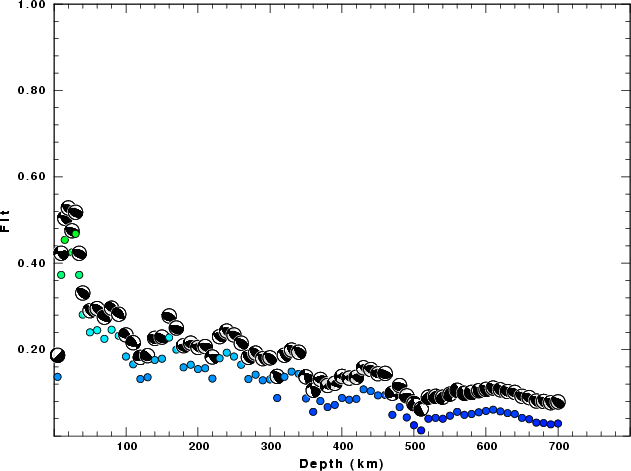
|
| Goodness of fit as a function of source depth. The measure is 1 - SUM (o -p)2 / SUM o2. A value of 1.0 is the best fit. The best double couple mechanism for the solution depth is plotted above goodness of fit value to indicate how the mefhanism may change with depth. |
| P-wave Z component |
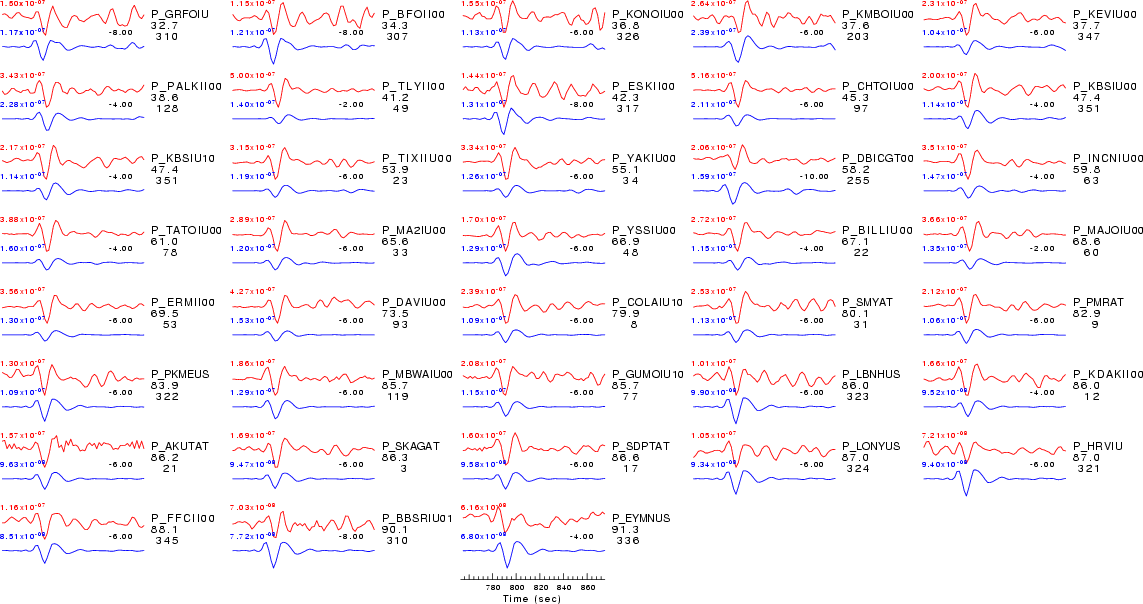
|
| Comparison of the observed traces (red) and solution predicted traces (blue) ordered in terms of increasing epicentral distance. Each pair of traces is annotated with the station name, epicentral distance in degrees, source to station azimuth in degrees. Each pair of traces is plotted with the same scale and the peak amplitudes are indicated at the lect of each trace. Finally the time shift between the P-wave first arrival picked and the the theoretical P-wave first arrival in the predicted trace is indicated, with a positive sign indicating that the predicted trace has been shifted to the right by the given number of seconds. as a function of source to station azimuth in degrees (D). The purpose of this display is to highlight the azimuthal dependence on the first motion. The traces are annotated with the station name at the top. |
| SH-wave T component |

|
| Comparison of the observed traces (red) and solution predicted traces (blue) ordered in terms of increasing epicentral distance. Each pair of traces is annotated with the station name, epicentral distance in degrees, source to station azimuth in degrees. Each pair of traces is plotted with the same scale and the peak amplitudes are indicated at the lect of each trace. Finally the time shift between the P-wave first arrival picked and the the theoretical P-wave first arrival in the predicted trace is indicated, with a positive sign indicating that the predicted trace has been shifted to the right by the given number of seconds. as a function of source to station azimuth in degrees (D). The purpose of this display is to highlight the azimuthal dependence on the first motion. The traces are annotated with the station name at the top. |
| SV-wave R component |

|
| Comparison of the observed traces (red) and solution predicted traces (blue) ordered in terms of increasing epicentral distance. Each pair of traces is annotated with the station name, epicentral distance in degrees, source to station azimuth in degrees. Each pair of traces is plotted with the same scale and the peak amplitudes are indicated at the lect of each trace. Finally the time shift between the P-wave first arrival picked and the the theoretical P-wave first arrival in the predicted trace is indicated, with a positive sign indicating that the predicted trace has been shifted to the right by the given number of seconds. as a function of source to station azimuth in degrees (D). The purpose of this display is to highlight the azimuthal dependence on the first motion. The traces are annotated with the station name at the top. |
All observed and Greens function waveforms are corrected to instrument response to ground velocity in meters/sec for the passband of 0.004 - 5 Hz. The traces were then lowpass filtered at 0.25 Hz and interpolated to a sample rate of 1 second.
For the grid search, the observed traces and Green's functions are read in an cut using the following commands
#####
# Driver script for the teleseismic waveform inversion
#
# The depth HS must be of the form 0010 for a depth of 1.0 km
# of 6700 for a depth of 670.0 km
#
# The Filter_Band is an integer with the following meansing
#
# FILTER_BAND 1/FH 1/FL
# 1 60 12 for Mw < 6.4
# 2 100 20 6.4 =< Mw < 6.8
# 3 120 40 6.8 =< Mw < 7.2
# 4 143 80 7.2 =< Mw < 9.3
#####
# Source duration - halfwidth of triangular function
# this filters only the Green functions
#
# halfwidth = 1.05 * 10-8 * M0^1/3 (M0 is dyne-cm)
#
# MW half-width (sec)
# 5.0 0.75
# 6.0 2.45
# 7.0 7.7
# 8.0 24.5
# 9.0 74.3
# 0.5*(MW - 9)
# or half-width=74.3*10
# or echo 5.33 | awk '{print 74.3*exp(0.5*log(10.0)*(0150 - 9.0)) }'
#####
# Processing window for P (use SAC variable A for P arrival
# Start A - 30
# End A + 2*HALFWIDTH + 0.03*HS + 30 + 1/FH
# Processing window for SH (use SAC variable T0 for SH arrival
# Start T0 - 60
# End T0 + 2*HALFWIDTH + 0.06*HS + 30 + 1/FH
# Processing window for SV (use SAC variable T1 for SV arrival
# Start T1 - 60
# End T1 + 2*HALFWIDTH + 0.06*HS + 30 + 1/FH
#
# The term involving HS serves to include the depth phases and
# to exclude the PP or SS at most distanace
#####
The cut windows attempt to include the P, pP, sP, pS, S and sS arrivals. However, oen must be very careful about the fact that PP may be included in some distance ranges.
The waveforms are then bandpass filtered by the application of the following high- and low-pass stages (an optional microseism filter):
hp c 0.0167 2 lp c 0.0833 2 int br c 0.12 0.25 n 4 p 2The traces were next integrated to ground displacment in meters. Finally the observed data are interpolated to ahve the same sampling at the Green's functions.
The source inversion is a multipass operation since a lower frequency filter band is used for larger earthquakes and since a search is made over depth. Up to three passed of the outer loop are made, after which the moment magnitude is determined and filter settings readjusted. The inner loop over depth samples all depths from 0 to 800 km with 5 km increments in depth to 50 km, followed by 10 km depth sampling for the remaining range.
The following filter ranges are used according to the moment magnitude Mw:
FILTER_BAND 1/FH(s) 1/FL(s)
1 60 12 Mw < 6.4
2 100 20 6.4 < Mw <= 6.9
3 120 40 Mw > 6.9
The map displays the distribution of stations used for this source inversion.
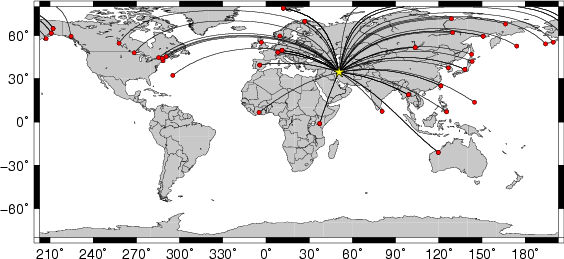
Location of the earthquake (yellow star) and great circle path from the epicenter to each station (red) [created using GMT (Wessel, P., and W. H. F. Smith, New version of Generic Mapping Tools released, EOS Trans. AGU, 76 329, 1995.)] |
For this data set the favored solution is
WVFGRD96 15.0 270 40 45 5.33 0.6151
The following figures show the sensitivity of the goodness of fit parameter so source depth, the waveform comparison as a function of epicentral distance in degrees and the source to station azimuth
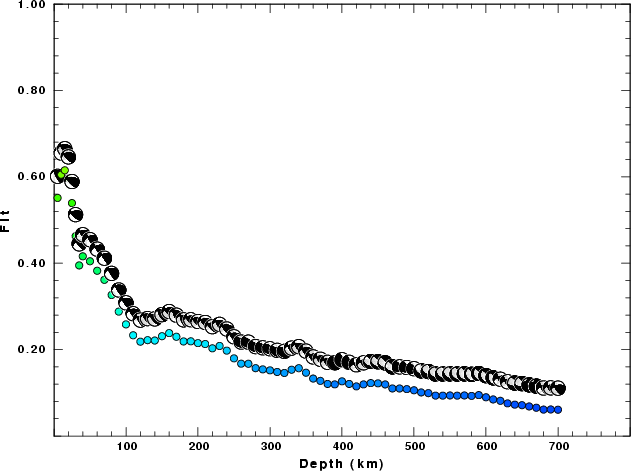
|
| Goodness of fit as a function of source depth. The measure is 1 - SUM (o -p)2 / SUM o2. A value of 1.0 is the best fit. The best double couple mechanism for the solution depth is plotted above goodness of fit value to indicate how the mefhanism may change with depth. |
| P-wave Z component |
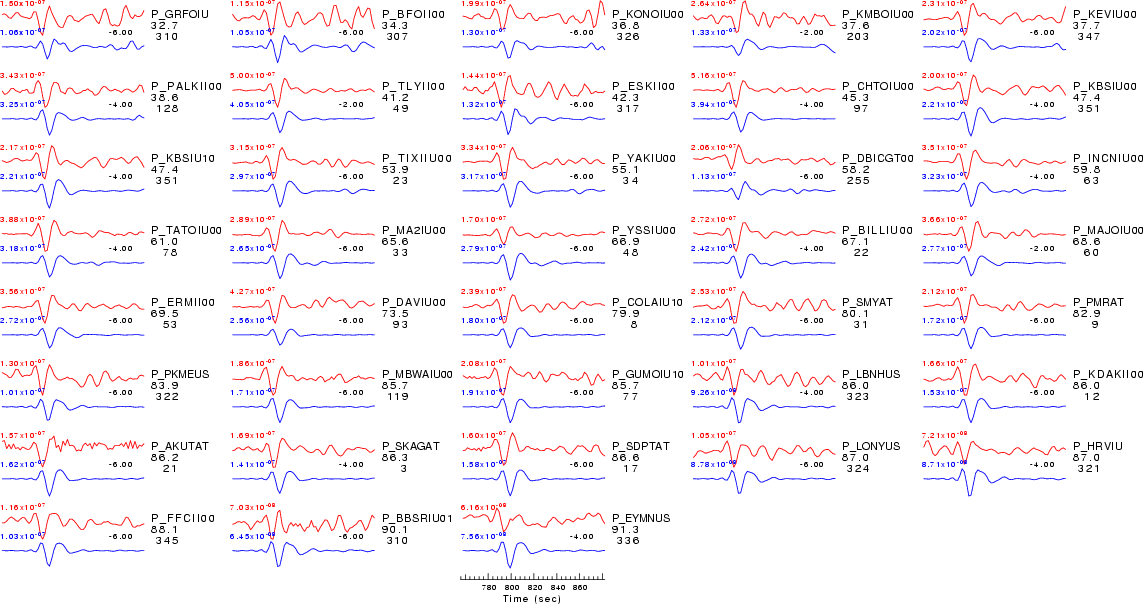
|
| Comparison of the observed traces (red) and solution predicted traces (blue) ordered in terms of increasing epicentral distance. Each pair of traces is annotated with the station name, epicentral distance in degrees, source to station azimuth in degrees. Each pair of traces is plotted with the same scale and the peak amplitudes are indicated at the lect of each trace. Finally the time shift between the P-wave first arrival picked and the the theoretical P-wave first arrival in the predicted trace is indicated, with a positive sign indicating that the predicted trace has been shifted to the right by the given number of seconds. as a function of source to station azimuth in degrees (D). The purpose of this display is to highlight the azimuthal dependence on the first motion. The traces are annotated with the station name at the top. |
| SH-wave T component |

|
| Comparison of the observed traces (red) and solution predicted traces (blue) ordered in terms of increasing epicentral distance. Each pair of traces is annotated with the station name, epicentral distance in degrees, source to station azimuth in degrees. Each pair of traces is plotted with the same scale and the peak amplitudes are indicated at the lect of each trace. Finally the time shift between the P-wave first arrival picked and the the theoretical P-wave first arrival in the predicted trace is indicated, with a positive sign indicating that the predicted trace has been shifted to the right by the given number of seconds. as a function of source to station azimuth in degrees (D). The purpose of this display is to highlight the azimuthal dependence on the first motion. The traces are annotated with the station name at the top. |
| SV-wave R component |

|
| Comparison of the observed traces (red) and solution predicted traces (blue) ordered in terms of increasing epicentral distance. Each pair of traces is annotated with the station name, epicentral distance in degrees, source to station azimuth in degrees. Each pair of traces is plotted with the same scale and the peak amplitudes are indicated at the lect of each trace. Finally the time shift between the P-wave first arrival picked and the the theoretical P-wave first arrival in the predicted trace is indicated, with a positive sign indicating that the predicted trace has been shifted to the right by the given number of seconds. as a function of source to station azimuth in degrees (D). The purpose of this display is to highlight the azimuthal dependence on the first motion. The traces are annotated with the station name at the top. |
All observed and Greens function waveforms are corrected to instrument response to ground velocity in meters/sec for the passband of 0.004 - 5 Hz. The traces were then lowpass filtered at 0.25 Hz and interpolated to a sample rate of 1 second.
For the grid search, the observed traces and Green's functions are read in an cut using the following commands
#####
# Driver script for the teleseismic waveform inversion
#
# The depth HS must be of the form 0010 for a depth of 1.0 km
# of 6700 for a depth of 670.0 km
#
# The Filter_Band is an integer with the following meansing
#
# FILTER_BAND 1/FH 1/FL
# 1 60 12 for Mw < 6.4
# 2 100 20 6.4 =< Mw < 6.8
# 3 120 40 6.8 =< Mw < 7.2
# 4 143 80 7.2 =< Mw < 9.3
#####
# Source duration - halfwidth of triangular function
# this filters only the Green functions
#
# halfwidth = 1.05 * 10-8 * M0^1/3 (M0 is dyne-cm)
#
# MW half-width (sec)
# 5.0 0.75
# 6.0 2.45
# 7.0 7.7
# 8.0 24.5
# 9.0 74.3
# 0.5*(MW - 9)
# or half-width=74.3*10
# or echo 5.57 | awk '{print 74.3*exp(0.5*log(10.0)*(0050 - 9.0)) }'
#####
# Processing window for P (use SAC variable A for P arrival
# Start A - 30
# End A + 2*HALFWIDTH + 0.03*HS + 30 + 1/FH
# Processing window for SH (use SAC variable T0 for SH arrival
# Start T0 - 60
# End T0 + 2*HALFWIDTH + 0.06*HS + 30 + 1/FH
# Processing window for SV (use SAC variable T1 for SV arrival
# Start T1 - 60
# End T1 + 2*HALFWIDTH + 0.06*HS + 30 + 1/FH
#
# The term involving HS serves to include the depth phases and
# to exclude the PP or SS at most distanace
#####
The cut windows attempt to include the P, pP, sP, pS, S and sS arrivals. However, oen must be very careful about the fact that PP may be included in some distance ranges.
The waveforms are then bandpass filtered by the application of the following high- and low-pass stages (an optional microseism filter):
hp c 0.0167 2 lp c 0.0833 2 int br c 0.12 0.25 n 4 p 2The traces were next integrated to ground displacment in meters. Finally the observed data are interpolated to ahve the same sampling at the Green's functions.
The source inversion is a multipass operation since a lower frequency filter band is used for larger earthquakes and since a search is made over depth. Up to three passed of the outer loop are made, after which the moment magnitude is determined and filter settings readjusted. The inner loop over depth samples all depths from 0 to 800 km with 5 km increments in depth to 50 km, followed by 10 km depth sampling for the remaining range.
The following filter ranges are used according to the moment magnitude Mw:
FILTER_BAND 1/FH(s) 1/FL(s)
1 60 12 Mw < 6.4
2 100 20 6.4 < Mw <= 6.9
3 120 40 Mw > 6.9
The map displays the distribution of stations used for this source inversion.
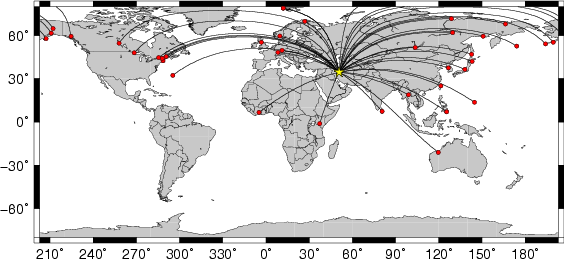
Location of the earthquake (yellow star) and great circle path from the epicenter to each station (red) [created using GMT (Wessel, P., and W. H. F. Smith, New version of Generic Mapping Tools released, EOS Trans. AGU, 76 329, 1995.)] |
For this data set the favored solution is
WVFGRD96 5.0 300 30 60 5.54 0.6560
The following figures show the sensitivity of the goodness of fit parameter so source depth, the waveform comparison as a function of epicentral distance in degrees and the source to station azimuth
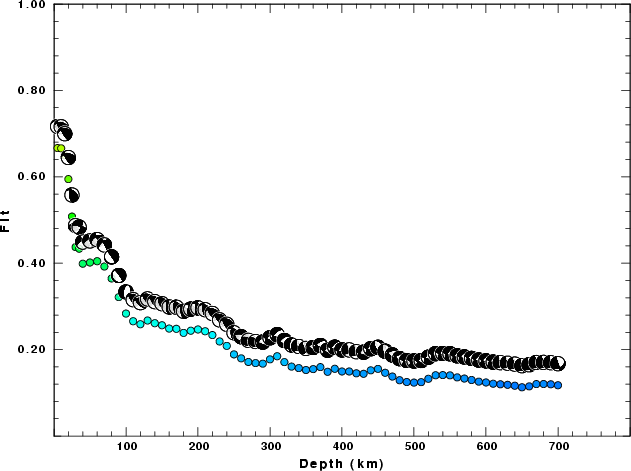
|
| Goodness of fit as a function of source depth. The measure is 1 - SUM (o -p)2 / SUM o2. A value of 1.0 is the best fit. The best double couple mechanism for the solution depth is plotted above goodness of fit value to indicate how the mefhanism may change with depth. |
| P-wave Z component |
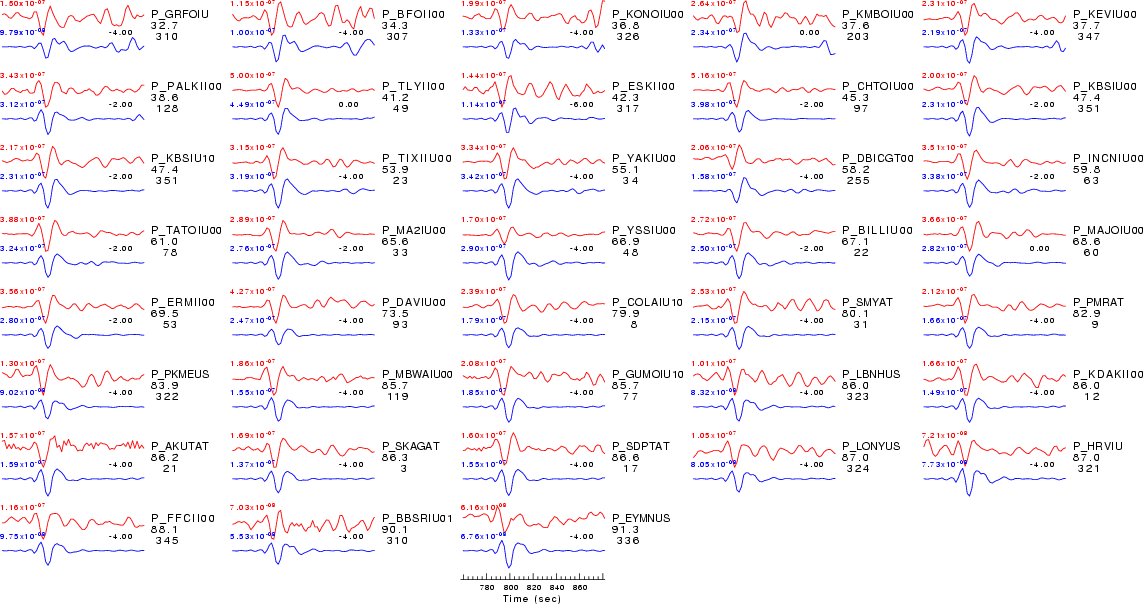
|
| Comparison of the observed traces (red) and solution predicted traces (blue) ordered in terms of increasing epicentral distance. Each pair of traces is annotated with the station name, epicentral distance in degrees, source to station azimuth in degrees. Each pair of traces is plotted with the same scale and the peak amplitudes are indicated at the lect of each trace. Finally the time shift between the P-wave first arrival picked and the the theoretical P-wave first arrival in the predicted trace is indicated, with a positive sign indicating that the predicted trace has been shifted to the right by the given number of seconds. as a function of source to station azimuth in degrees (D). The purpose of this display is to highlight the azimuthal dependence on the first motion. The traces are annotated with the station name at the top. |
Starting Processing : Mon Jun 18 15:40:23 UTC 2007 Starting query to get files : Mon Jun 18 15:40:23 UTC 2007 Starting stareq for response: Mon Jun 18 15:48:46 UTC 2007 Starting deconvolution : Mon Jun 18 15:51:26 UTC 2007 Starting trace rotation : Mon Jun 18 15:53:19 UTC 2007 Starting distance selection : Mon Jun 18 15:53:46 UTC 2007 Starting trace QC : Mon Jun 18 15:53:54 UTC 2007 Starting Grid Search : Mon Jun 18 16:00:32 UTC 2007 Starting MTD : Mon Jun 18 16:09:54 UTC 2007 Starting documentation : Mon Jun 18 16:16:22 UTC 2007 Processing Completion : Mon Jun 18 16:16:22 UTC 2007